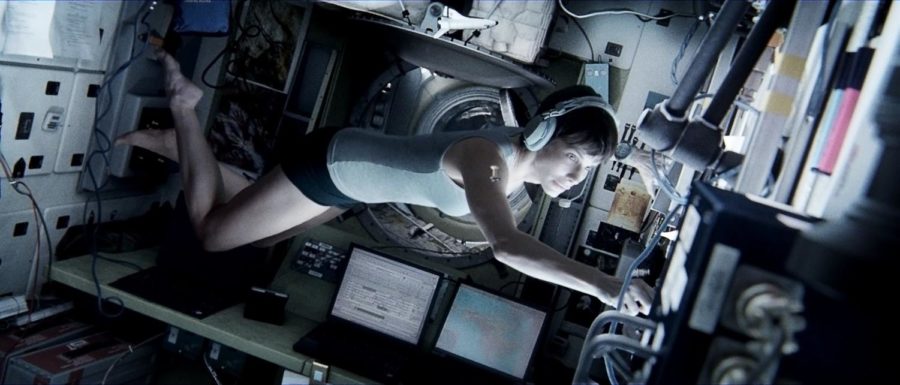Oscar-nominated director Alfonso Cuarón just released what is probably the most visually stunning space movie yet. But it isn’t just a pretty face. Gravity, starring Sandra Bullock, George Clooney, and an unseen Ed Harris as the voice of ‘Houston,’ is a thriller that takes the audience on an emotional rollercoaster the likes of which have never been seen.
Unlike most movies about space, aliens do not feature in Gravity. The storyline revolves around genius engineer and first time astronaut Ryan Stone (Bullock) set adrift in space after a Russian satellite explodes, causing a shrapnel collision that destroys her spacecraft. Throughout the duration of the 90-minute movie, Bullock ceaselessly faces life-threatening danger as the growing cloud of shrapnel continues to orbit the earth.
Apart from Stone, the only other character featured on the screen is Matt Kowalski (Clooney), a veteran astronaut who likes to tell life stories and joke around. The two characters function as opposites in this respect; where Kowalski is sociable, Stone is quiet and aloof. She loves space because of the silence. This love of silence, we learn, is in many ways a consequence of the fact that Stone is haunted by the memory of her dead child. The already-harrowing struggle to survive the shrapnel and get back to earth, the drama of trying to decipher Russian and Chinese instructions on a foreign space-craft, and the new layer of conflict added by this haunting memory is, arguably, a little too much. Yet this last personal story ultimately leads to a moving monologue in which Stone finds the will to survive.
The visual effects of the movie are striking. In 3D format, everything that’s happening on screen looks unquestionably realistic. Especially noteworthy is a scene immediately after the original collision occurs. As Sandra Bullock is thrust into space, she is continuously spinning, and while she spins, the audience spins with her. We see what she sees: space, debris, earth, space, debris. The effect is so realistic that one becomes almost nauseous watching her. The physics of the movie are also very impressive—the way the astronauts drift in space, whether still attached to a spacecraft or trying to get to a shuttle, seems perfectly calculated. And while the actionpacked scenes are visually striking, they are often interrupted by serene and even more beautiful scenes in which one can recognize geographical details of our planet, such as the Nile or Italy. One of the most visually spectacular scenes of the movies is when Kowalski (Clooney) takes a moment to reflect and watch the sunrise on earth.
Silence is clearly a theme of the movie, but it is one thing when Bullock’s character talks about it and another to hear it in the movie theater. Naturally, all the action scenes are noisy, with the occasional loud “whomps” as Sandra Bullock lands on space stations, or high-pitched noises coming from the ship’s countless mechanisms. Still, Gravity is not a very loud movie, and this feature definitely emphasizes the thrill. Numerous scenes find Bullock alone in space, and when not conversing desperately with Houston and/or Kowalski, her hurried breathing dominates the soundscape.
Gravity is not one of those movies that you should watch on your computer or iPad. The spectacular visual effects and the absence of the stereotypical action-movie sound accompaniment need a big screen and big speakers to be appreciated to the full extent. This, coupled with a gripping storyline and characters who continue to engage even as they drift alone through the empty void of space, makes Gravity a visual wonder that truly must be seen to be believed.
Gravity, directed by Alfonso Cuarón, is playing at AMC River East 21.









